Law Report: Determining Employment Status: Amanda and Ken's Cases
VerifiedAdded on 2020/05/11
|8
|1810
|79
Report
AI Summary
This law report examines the legal distinctions between employees and independent contractors, focusing on the cases of Amanda and Ken. The report delves into the factors courts consider when determining employment status, such as control exercised by the company, integration into the business, remuneration, and employee benefits. It contrasts contracts of service with contracts for service and analyzes whether Amanda is an employee or an independent contractor of Monks Pty Ltd, concluding that she is an employee. The report also addresses Ken's right to challenge a retrenchment decision, examining the 'last in, first out' rule and its limitations. The analysis includes relevant case law and legal principles to support the conclusions.

Running Head: Law 1
Law
Law
Paraphrase This Document
Need a fresh take? Get an instant paraphrase of this document with our AI Paraphraser
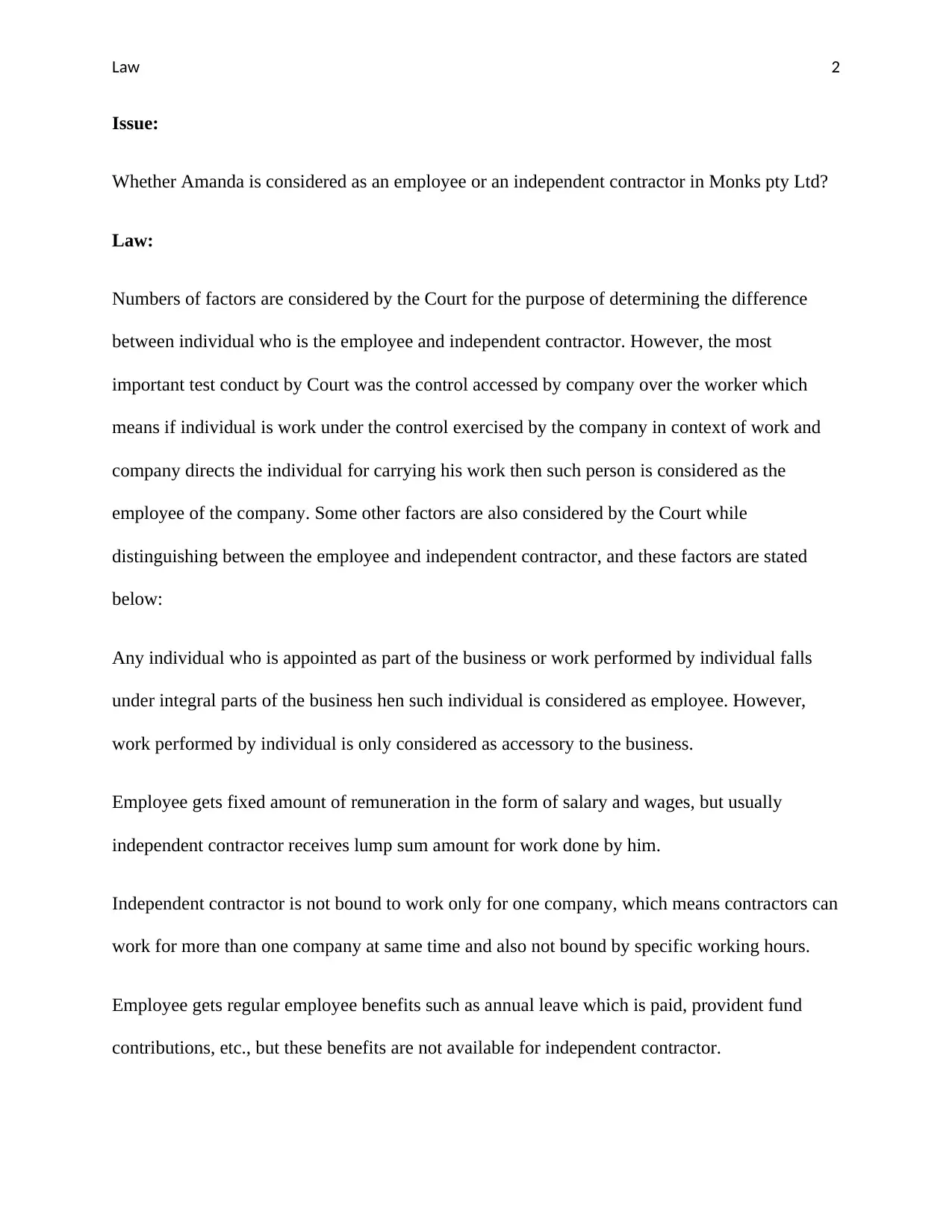
Law 2
Issue:
Whether Amanda is considered as an employee or an independent contractor in Monks pty Ltd?
Law:
Numbers of factors are considered by the Court for the purpose of determining the difference
between individual who is the employee and independent contractor. However, the most
important test conduct by Court was the control accessed by company over the worker which
means if individual is work under the control exercised by the company in context of work and
company directs the individual for carrying his work then such person is considered as the
employee of the company. Some other factors are also considered by the Court while
distinguishing between the employee and independent contractor, and these factors are stated
below:
Any individual who is appointed as part of the business or work performed by individual falls
under integral parts of the business hen such individual is considered as employee. However,
work performed by individual is only considered as accessory to the business.
Employee gets fixed amount of remuneration in the form of salary and wages, but usually
independent contractor receives lump sum amount for work done by him.
Independent contractor is not bound to work only for one company, which means contractors can
work for more than one company at same time and also not bound by specific working hours.
Employee gets regular employee benefits such as annual leave which is paid, provident fund
contributions, etc., but these benefits are not available for independent contractor.
Issue:
Whether Amanda is considered as an employee or an independent contractor in Monks pty Ltd?
Law:
Numbers of factors are considered by the Court for the purpose of determining the difference
between individual who is the employee and independent contractor. However, the most
important test conduct by Court was the control accessed by company over the worker which
means if individual is work under the control exercised by the company in context of work and
company directs the individual for carrying his work then such person is considered as the
employee of the company. Some other factors are also considered by the Court while
distinguishing between the employee and independent contractor, and these factors are stated
below:
Any individual who is appointed as part of the business or work performed by individual falls
under integral parts of the business hen such individual is considered as employee. However,
work performed by individual is only considered as accessory to the business.
Employee gets fixed amount of remuneration in the form of salary and wages, but usually
independent contractor receives lump sum amount for work done by him.
Independent contractor is not bound to work only for one company, which means contractors can
work for more than one company at same time and also not bound by specific working hours.
Employee gets regular employee benefits such as annual leave which is paid, provident fund
contributions, etc., but these benefits are not available for independent contractor.
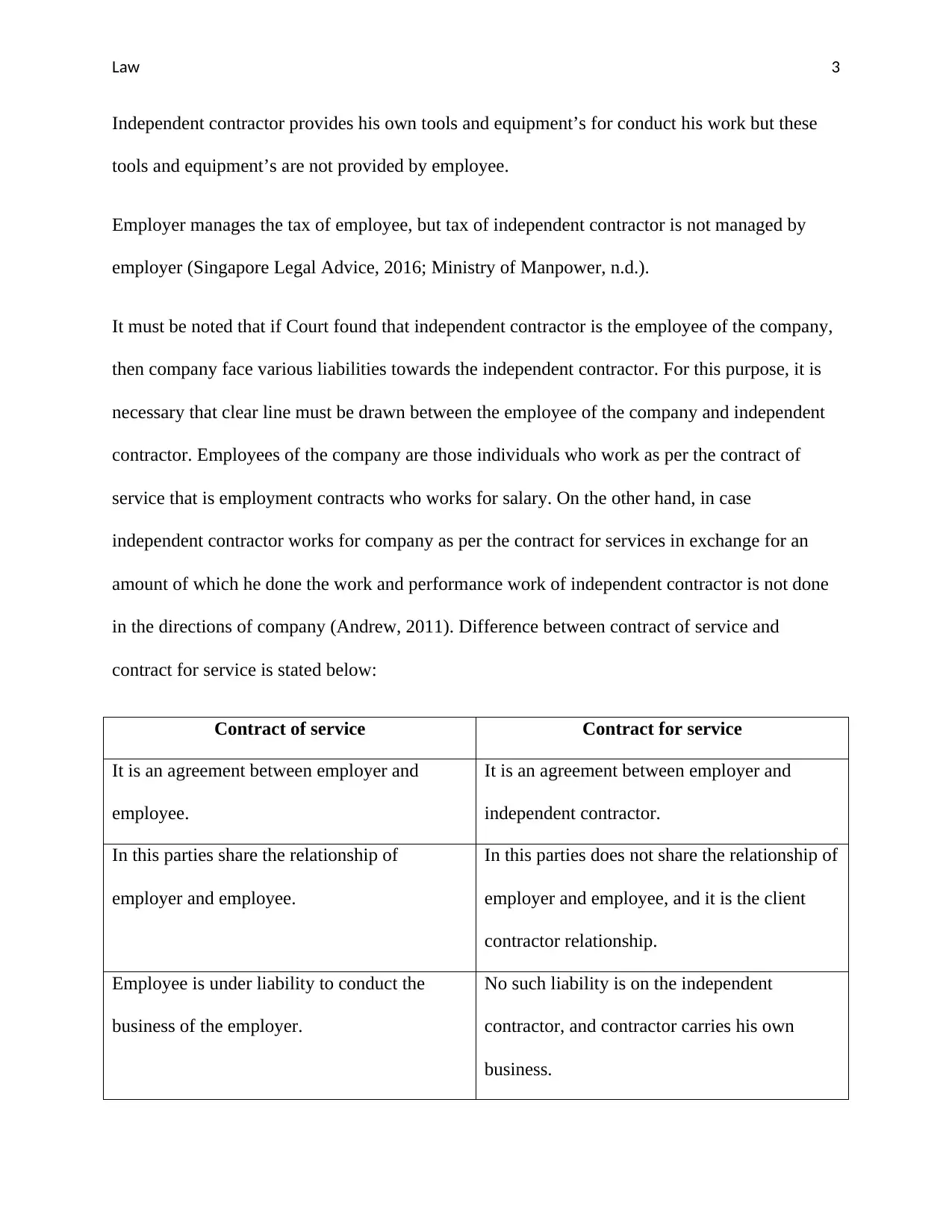
Law 3
Independent contractor provides his own tools and equipment’s for conduct his work but these
tools and equipment’s are not provided by employee.
Employer manages the tax of employee, but tax of independent contractor is not managed by
employer (Singapore Legal Advice, 2016; Ministry of Manpower, n.d.).
It must be noted that if Court found that independent contractor is the employee of the company,
then company face various liabilities towards the independent contractor. For this purpose, it is
necessary that clear line must be drawn between the employee of the company and independent
contractor. Employees of the company are those individuals who work as per the contract of
service that is employment contracts who works for salary. On the other hand, in case
independent contractor works for company as per the contract for services in exchange for an
amount of which he done the work and performance work of independent contractor is not done
in the directions of company (Andrew, 2011). Difference between contract of service and
contract for service is stated below:
Contract of service Contract for service
It is an agreement between employer and
employee.
It is an agreement between employer and
independent contractor.
In this parties share the relationship of
employer and employee.
In this parties does not share the relationship of
employer and employee, and it is the client
contractor relationship.
Employee is under liability to conduct the
business of the employer.
No such liability is on the independent
contractor, and contractor carries his own
business.
Independent contractor provides his own tools and equipment’s for conduct his work but these
tools and equipment’s are not provided by employee.
Employer manages the tax of employee, but tax of independent contractor is not managed by
employer (Singapore Legal Advice, 2016; Ministry of Manpower, n.d.).
It must be noted that if Court found that independent contractor is the employee of the company,
then company face various liabilities towards the independent contractor. For this purpose, it is
necessary that clear line must be drawn between the employee of the company and independent
contractor. Employees of the company are those individuals who work as per the contract of
service that is employment contracts who works for salary. On the other hand, in case
independent contractor works for company as per the contract for services in exchange for an
amount of which he done the work and performance work of independent contractor is not done
in the directions of company (Andrew, 2011). Difference between contract of service and
contract for service is stated below:
Contract of service Contract for service
It is an agreement between employer and
employee.
It is an agreement between employer and
independent contractor.
In this parties share the relationship of
employer and employee.
In this parties does not share the relationship of
employer and employee, and it is the client
contractor relationship.
Employee is under liability to conduct the
business of the employer.
No such liability is on the independent
contractor, and contractor carries his own
business.
⊘ This is a preview!⊘
Do you want full access?
Subscribe today to unlock all pages.

Trusted by 1+ million students worldwide
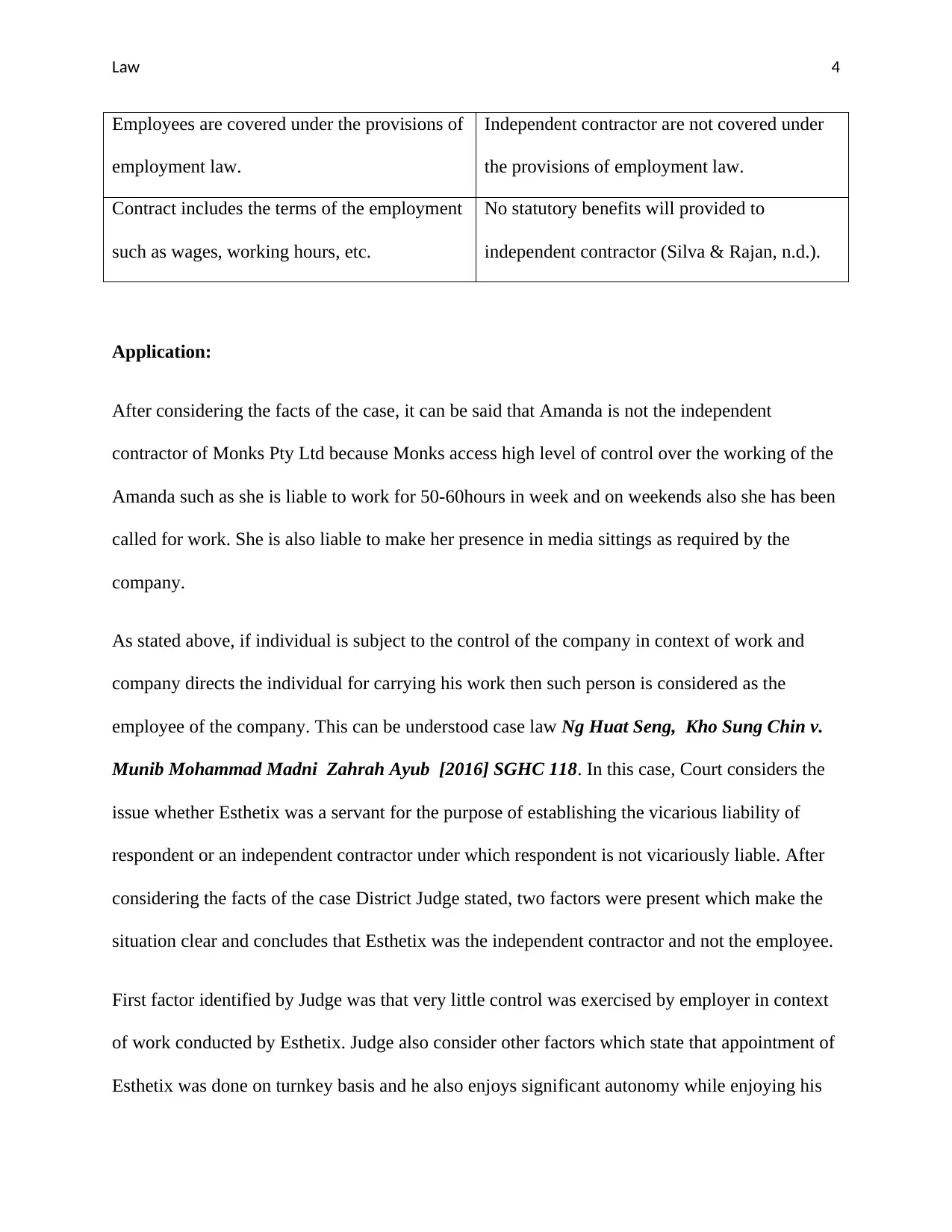
Law 4
Employees are covered under the provisions of
employment law.
Independent contractor are not covered under
the provisions of employment law.
Contract includes the terms of the employment
such as wages, working hours, etc.
No statutory benefits will provided to
independent contractor (Silva & Rajan, n.d.).
Application:
After considering the facts of the case, it can be said that Amanda is not the independent
contractor of Monks Pty Ltd because Monks access high level of control over the working of the
Amanda such as she is liable to work for 50-60hours in week and on weekends also she has been
called for work. She is also liable to make her presence in media sittings as required by the
company.
As stated above, if individual is subject to the control of the company in context of work and
company directs the individual for carrying his work then such person is considered as the
employee of the company. This can be understood case law Ng Huat Seng, Kho Sung Chin v.
Munib Mohammad Madni Zahrah Ayub [2016] SGHC 118. In this case, Court considers the
issue whether Esthetix was a servant for the purpose of establishing the vicarious liability of
respondent or an independent contractor under which respondent is not vicariously liable. After
considering the facts of the case District Judge stated, two factors were present which make the
situation clear and concludes that Esthetix was the independent contractor and not the employee.
First factor identified by Judge was that very little control was exercised by employer in context
of work conducted by Esthetix. Judge also consider other factors which state that appointment of
Esthetix was done on turnkey basis and he also enjoys significant autonomy while enjoying his
Employees are covered under the provisions of
employment law.
Independent contractor are not covered under
the provisions of employment law.
Contract includes the terms of the employment
such as wages, working hours, etc.
No statutory benefits will provided to
independent contractor (Silva & Rajan, n.d.).
Application:
After considering the facts of the case, it can be said that Amanda is not the independent
contractor of Monks Pty Ltd because Monks access high level of control over the working of the
Amanda such as she is liable to work for 50-60hours in week and on weekends also she has been
called for work. She is also liable to make her presence in media sittings as required by the
company.
As stated above, if individual is subject to the control of the company in context of work and
company directs the individual for carrying his work then such person is considered as the
employee of the company. This can be understood case law Ng Huat Seng, Kho Sung Chin v.
Munib Mohammad Madni Zahrah Ayub [2016] SGHC 118. In this case, Court considers the
issue whether Esthetix was a servant for the purpose of establishing the vicarious liability of
respondent or an independent contractor under which respondent is not vicariously liable. After
considering the facts of the case District Judge stated, two factors were present which make the
situation clear and concludes that Esthetix was the independent contractor and not the employee.
First factor identified by Judge was that very little control was exercised by employer in context
of work conducted by Esthetix. Judge also consider other factors which state that appointment of
Esthetix was done on turnkey basis and he also enjoys significant autonomy while enjoying his
Paraphrase This Document
Need a fresh take? Get an instant paraphrase of this document with our AI Paraphraser
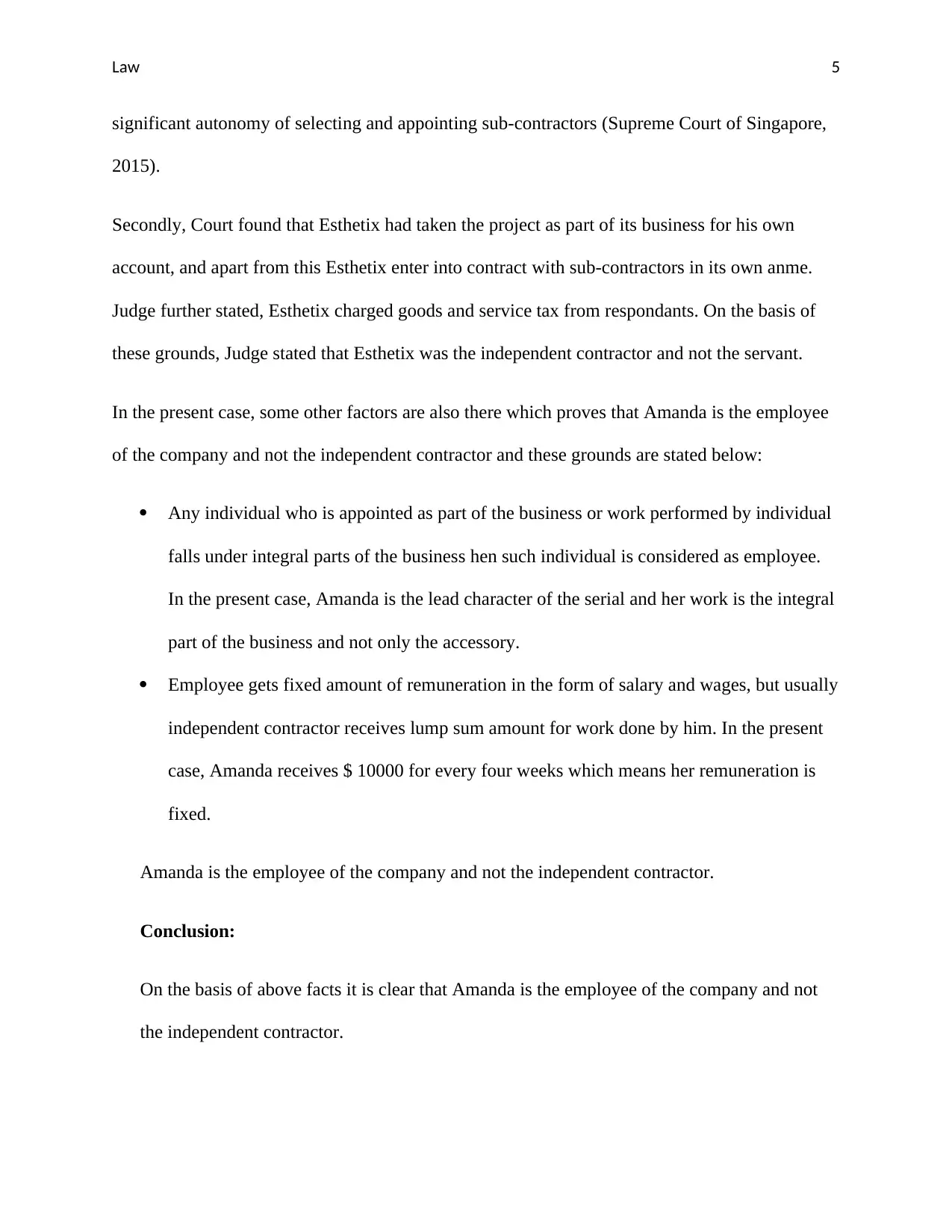
Law 5
significant autonomy of selecting and appointing sub-contractors (Supreme Court of Singapore,
2015).
Secondly, Court found that Esthetix had taken the project as part of its business for his own
account, and apart from this Esthetix enter into contract with sub-contractors in its own anme.
Judge further stated, Esthetix charged goods and service tax from respondants. On the basis of
these grounds, Judge stated that Esthetix was the independent contractor and not the servant.
In the present case, some other factors are also there which proves that Amanda is the employee
of the company and not the independent contractor and these grounds are stated below:
Any individual who is appointed as part of the business or work performed by individual
falls under integral parts of the business hen such individual is considered as employee.
In the present case, Amanda is the lead character of the serial and her work is the integral
part of the business and not only the accessory.
Employee gets fixed amount of remuneration in the form of salary and wages, but usually
independent contractor receives lump sum amount for work done by him. In the present
case, Amanda receives $ 10000 for every four weeks which means her remuneration is
fixed.
Amanda is the employee of the company and not the independent contractor.
Conclusion:
On the basis of above facts it is clear that Amanda is the employee of the company and not
the independent contractor.
significant autonomy of selecting and appointing sub-contractors (Supreme Court of Singapore,
2015).
Secondly, Court found that Esthetix had taken the project as part of its business for his own
account, and apart from this Esthetix enter into contract with sub-contractors in its own anme.
Judge further stated, Esthetix charged goods and service tax from respondants. On the basis of
these grounds, Judge stated that Esthetix was the independent contractor and not the servant.
In the present case, some other factors are also there which proves that Amanda is the employee
of the company and not the independent contractor and these grounds are stated below:
Any individual who is appointed as part of the business or work performed by individual
falls under integral parts of the business hen such individual is considered as employee.
In the present case, Amanda is the lead character of the serial and her work is the integral
part of the business and not only the accessory.
Employee gets fixed amount of remuneration in the form of salary and wages, but usually
independent contractor receives lump sum amount for work done by him. In the present
case, Amanda receives $ 10000 for every four weeks which means her remuneration is
fixed.
Amanda is the employee of the company and not the independent contractor.
Conclusion:
On the basis of above facts it is clear that Amanda is the employee of the company and not
the independent contractor.
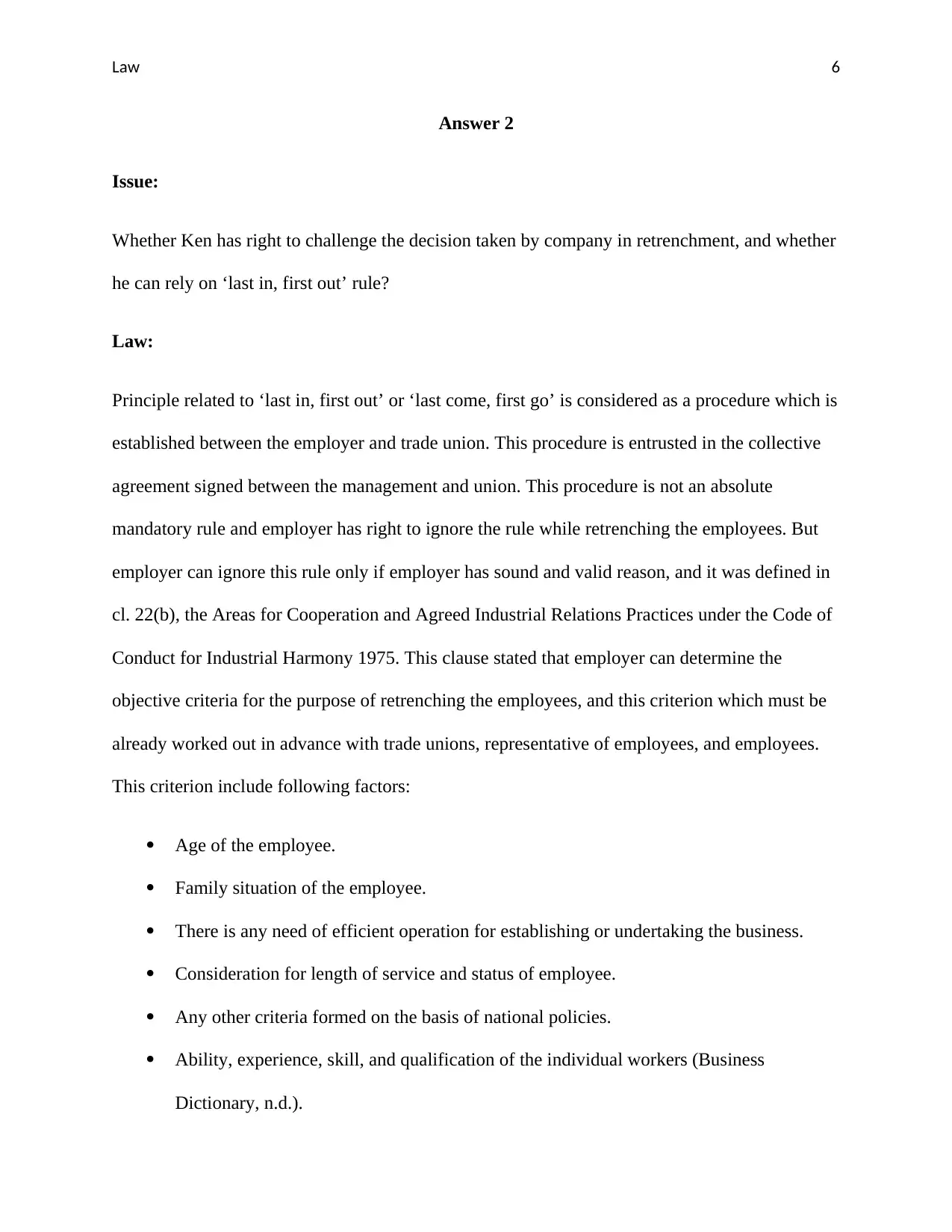
Law 6
Answer 2
Issue:
Whether Ken has right to challenge the decision taken by company in retrenchment, and whether
he can rely on ‘last in, first out’ rule?
Law:
Principle related to ‘last in, first out’ or ‘last come, first go’ is considered as a procedure which is
established between the employer and trade union. This procedure is entrusted in the collective
agreement signed between the management and union. This procedure is not an absolute
mandatory rule and employer has right to ignore the rule while retrenching the employees. But
employer can ignore this rule only if employer has sound and valid reason, and it was defined in
cl. 22(b), the Areas for Cooperation and Agreed Industrial Relations Practices under the Code of
Conduct for Industrial Harmony 1975. This clause stated that employer can determine the
objective criteria for the purpose of retrenching the employees, and this criterion which must be
already worked out in advance with trade unions, representative of employees, and employees.
This criterion include following factors:
Age of the employee.
Family situation of the employee.
There is any need of efficient operation for establishing or undertaking the business.
Consideration for length of service and status of employee.
Any other criteria formed on the basis of national policies.
Ability, experience, skill, and qualification of the individual workers (Business
Dictionary, n.d.).
Answer 2
Issue:
Whether Ken has right to challenge the decision taken by company in retrenchment, and whether
he can rely on ‘last in, first out’ rule?
Law:
Principle related to ‘last in, first out’ or ‘last come, first go’ is considered as a procedure which is
established between the employer and trade union. This procedure is entrusted in the collective
agreement signed between the management and union. This procedure is not an absolute
mandatory rule and employer has right to ignore the rule while retrenching the employees. But
employer can ignore this rule only if employer has sound and valid reason, and it was defined in
cl. 22(b), the Areas for Cooperation and Agreed Industrial Relations Practices under the Code of
Conduct for Industrial Harmony 1975. This clause stated that employer can determine the
objective criteria for the purpose of retrenching the employees, and this criterion which must be
already worked out in advance with trade unions, representative of employees, and employees.
This criterion include following factors:
Age of the employee.
Family situation of the employee.
There is any need of efficient operation for establishing or undertaking the business.
Consideration for length of service and status of employee.
Any other criteria formed on the basis of national policies.
Ability, experience, skill, and qualification of the individual workers (Business
Dictionary, n.d.).
⊘ This is a preview!⊘
Do you want full access?
Subscribe today to unlock all pages.

Trusted by 1+ million students worldwide
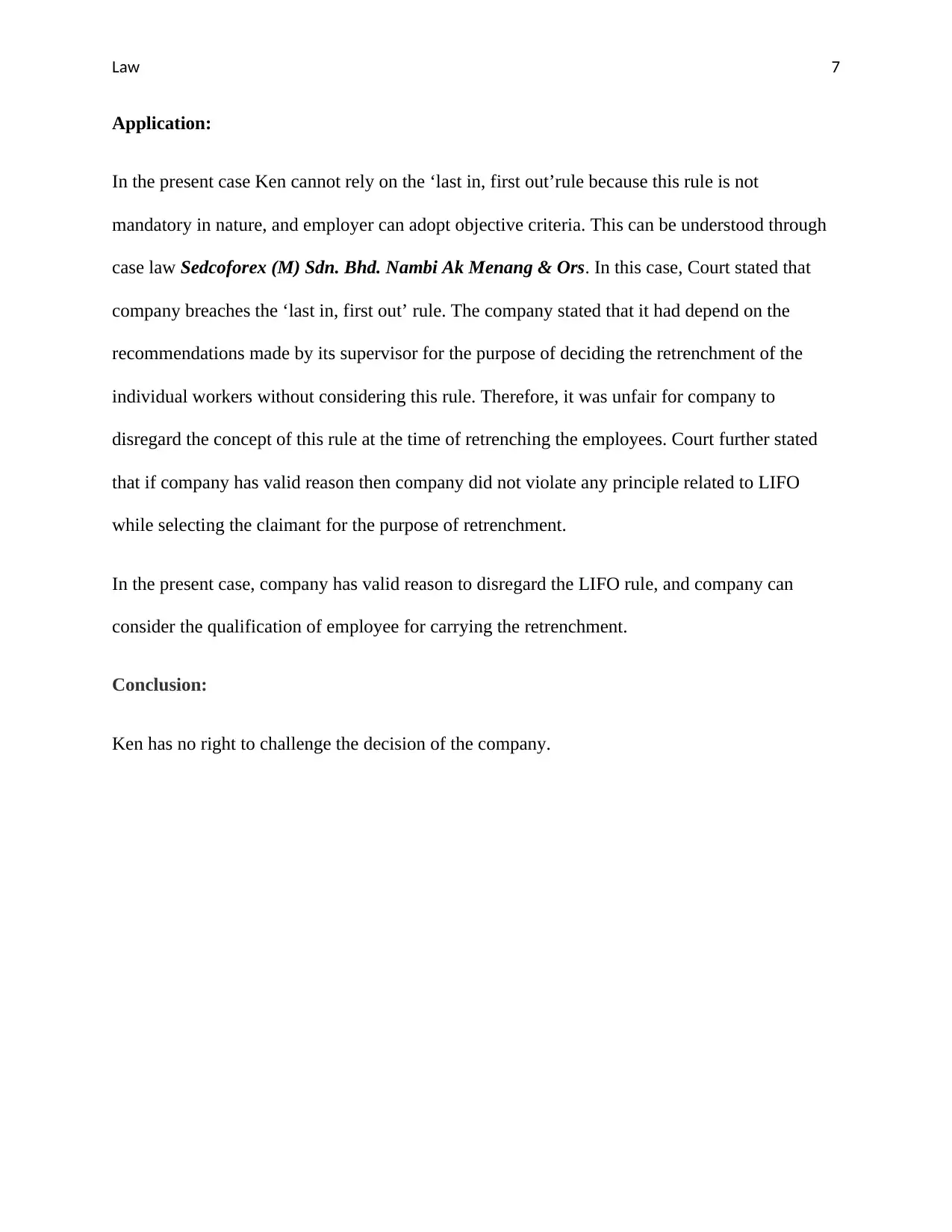
Law 7
Application:
In the present case Ken cannot rely on the ‘last in, first out’rule because this rule is not
mandatory in nature, and employer can adopt objective criteria. This can be understood through
case law Sedcoforex (M) Sdn. Bhd. Nambi Ak Menang & Ors. In this case, Court stated that
company breaches the ‘last in, first out’ rule. The company stated that it had depend on the
recommendations made by its supervisor for the purpose of deciding the retrenchment of the
individual workers without considering this rule. Therefore, it was unfair for company to
disregard the concept of this rule at the time of retrenching the employees. Court further stated
that if company has valid reason then company did not violate any principle related to LIFO
while selecting the claimant for the purpose of retrenchment.
In the present case, company has valid reason to disregard the LIFO rule, and company can
consider the qualification of employee for carrying the retrenchment.
Conclusion:
Ken has no right to challenge the decision of the company.
Application:
In the present case Ken cannot rely on the ‘last in, first out’rule because this rule is not
mandatory in nature, and employer can adopt objective criteria. This can be understood through
case law Sedcoforex (M) Sdn. Bhd. Nambi Ak Menang & Ors. In this case, Court stated that
company breaches the ‘last in, first out’ rule. The company stated that it had depend on the
recommendations made by its supervisor for the purpose of deciding the retrenchment of the
individual workers without considering this rule. Therefore, it was unfair for company to
disregard the concept of this rule at the time of retrenching the employees. Court further stated
that if company has valid reason then company did not violate any principle related to LIFO
while selecting the claimant for the purpose of retrenchment.
In the present case, company has valid reason to disregard the LIFO rule, and company can
consider the qualification of employee for carrying the retrenchment.
Conclusion:
Ken has no right to challenge the decision of the company.
Paraphrase This Document
Need a fresh take? Get an instant paraphrase of this document with our AI Paraphraser
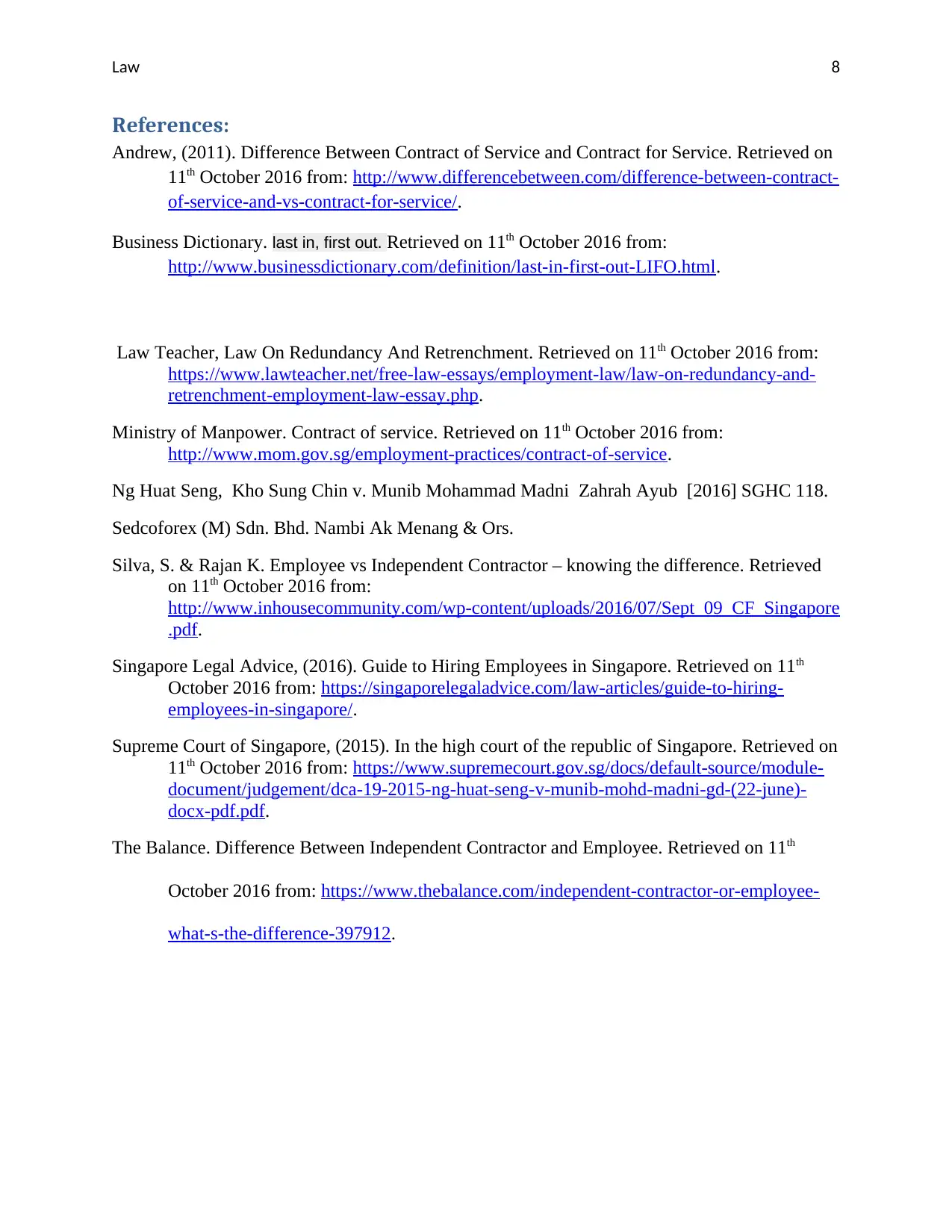
Law 8
References:
Andrew, (2011). Difference Between Contract of Service and Contract for Service. Retrieved on
11th October 2016 from: http://www.differencebetween.com/difference-between-contract-
of-service-and-vs-contract-for-service/.
Business Dictionary. last in, first out. Retrieved on 11th October 2016 from:
http://www.businessdictionary.com/definition/last-in-first-out-LIFO.html.
Law Teacher, Law On Redundancy And Retrenchment. Retrieved on 11th October 2016 from:
https://www.lawteacher.net/free-law-essays/employment-law/law-on-redundancy-and-
retrenchment-employment-law-essay.php.
Ministry of Manpower. Contract of service. Retrieved on 11th October 2016 from:
http://www.mom.gov.sg/employment-practices/contract-of-service.
Ng Huat Seng, Kho Sung Chin v. Munib Mohammad Madni Zahrah Ayub [2016] SGHC 118.
Sedcoforex (M) Sdn. Bhd. Nambi Ak Menang & Ors.
Silva, S. & Rajan K. Employee vs Independent Contractor – knowing the difference. Retrieved
on 11th October 2016 from:
http://www.inhousecommunity.com/wp-content/uploads/2016/07/Sept_09_CF_Singapore
.pdf.
Singapore Legal Advice, (2016). Guide to Hiring Employees in Singapore. Retrieved on 11th
October 2016 from: https://singaporelegaladvice.com/law-articles/guide-to-hiring-
employees-in-singapore/.
Supreme Court of Singapore, (2015). In the high court of the republic of Singapore. Retrieved on
11th October 2016 from: https://www.supremecourt.gov.sg/docs/default-source/module-
document/judgement/dca-19-2015-ng-huat-seng-v-munib-mohd-madni-gd-(22-june)-
docx-pdf.pdf.
The Balance. Difference Between Independent Contractor and Employee. Retrieved on 11th
October 2016 from: https://www.thebalance.com/independent-contractor-or-employee-
what-s-the-difference-397912.
References:
Andrew, (2011). Difference Between Contract of Service and Contract for Service. Retrieved on
11th October 2016 from: http://www.differencebetween.com/difference-between-contract-
of-service-and-vs-contract-for-service/.
Business Dictionary. last in, first out. Retrieved on 11th October 2016 from:
http://www.businessdictionary.com/definition/last-in-first-out-LIFO.html.
Law Teacher, Law On Redundancy And Retrenchment. Retrieved on 11th October 2016 from:
https://www.lawteacher.net/free-law-essays/employment-law/law-on-redundancy-and-
retrenchment-employment-law-essay.php.
Ministry of Manpower. Contract of service. Retrieved on 11th October 2016 from:
http://www.mom.gov.sg/employment-practices/contract-of-service.
Ng Huat Seng, Kho Sung Chin v. Munib Mohammad Madni Zahrah Ayub [2016] SGHC 118.
Sedcoforex (M) Sdn. Bhd. Nambi Ak Menang & Ors.
Silva, S. & Rajan K. Employee vs Independent Contractor – knowing the difference. Retrieved
on 11th October 2016 from:
http://www.inhousecommunity.com/wp-content/uploads/2016/07/Sept_09_CF_Singapore
.pdf.
Singapore Legal Advice, (2016). Guide to Hiring Employees in Singapore. Retrieved on 11th
October 2016 from: https://singaporelegaladvice.com/law-articles/guide-to-hiring-
employees-in-singapore/.
Supreme Court of Singapore, (2015). In the high court of the republic of Singapore. Retrieved on
11th October 2016 from: https://www.supremecourt.gov.sg/docs/default-source/module-
document/judgement/dca-19-2015-ng-huat-seng-v-munib-mohd-madni-gd-(22-june)-
docx-pdf.pdf.
The Balance. Difference Between Independent Contractor and Employee. Retrieved on 11th
October 2016 from: https://www.thebalance.com/independent-contractor-or-employee-
what-s-the-difference-397912.
1 out of 8
Related Documents
Your All-in-One AI-Powered Toolkit for Academic Success.
+13062052269
info@desklib.com
Available 24*7 on WhatsApp / Email
![[object Object]](/_next/static/media/star-bottom.7253800d.svg)
Unlock your academic potential
Copyright © 2020–2025 A2Z Services. All Rights Reserved. Developed and managed by ZUCOL.





